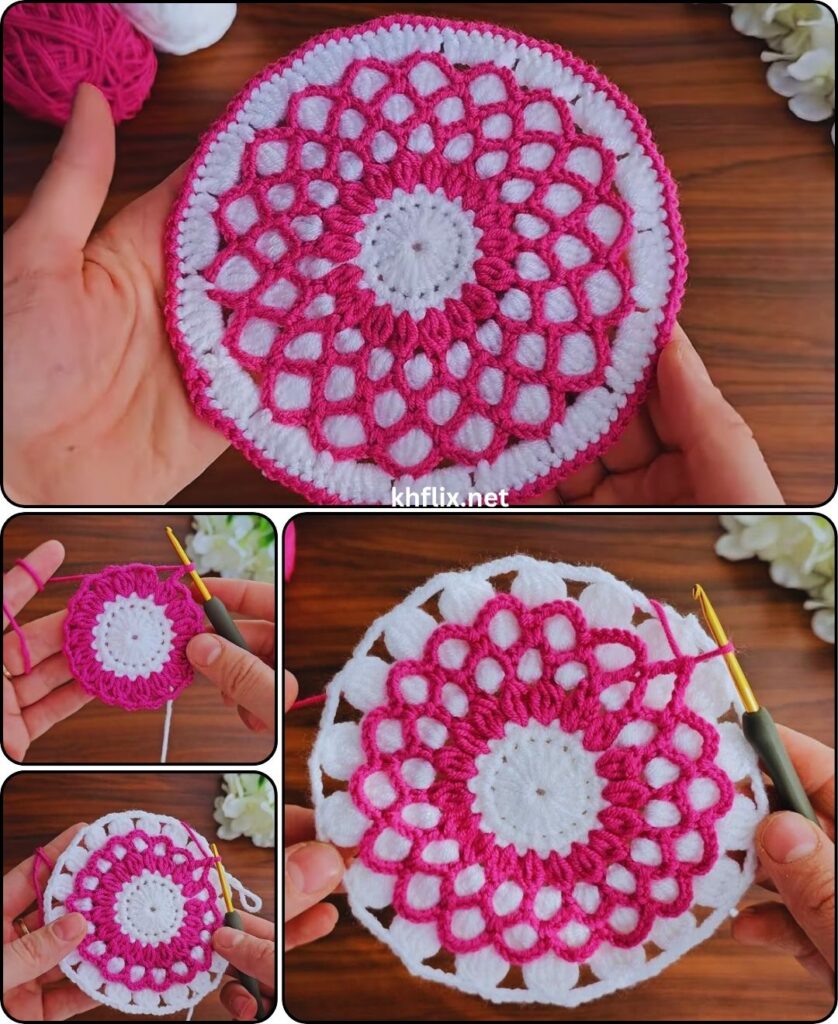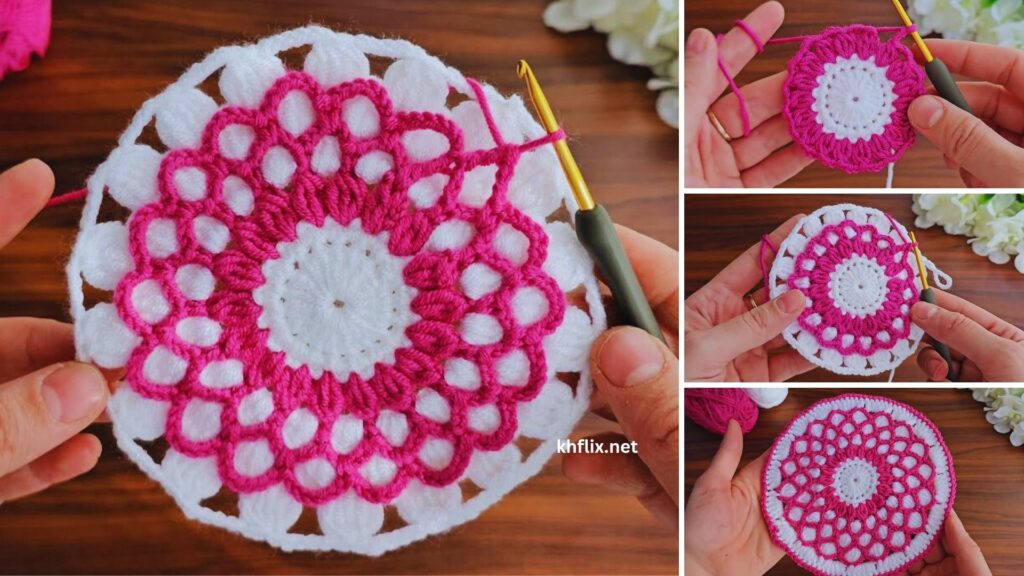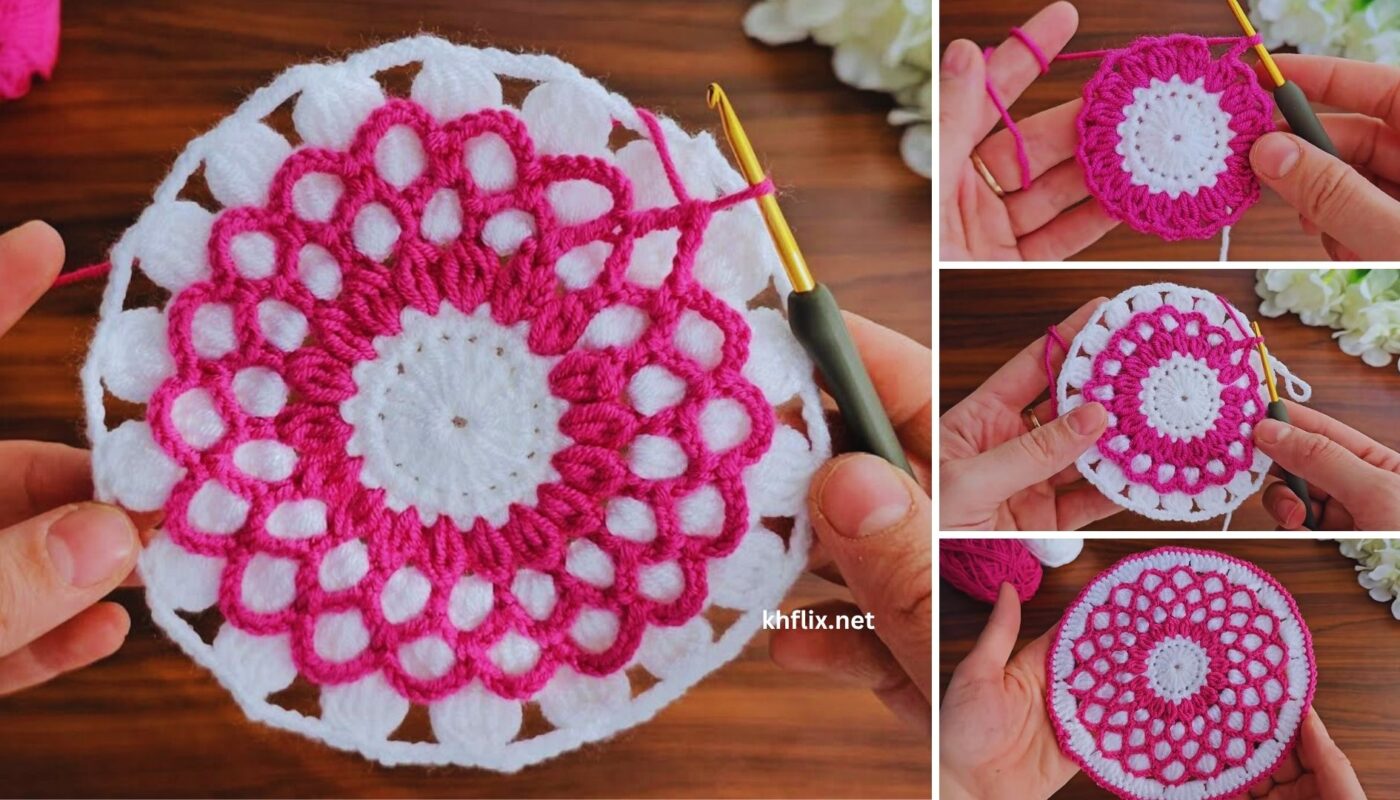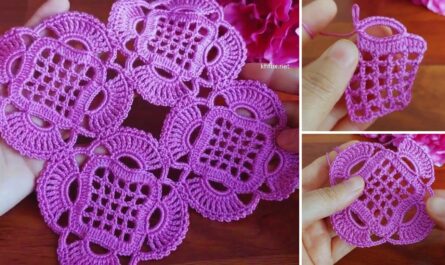You’re looking to create a beautiful, large Flower Coaster Supla Motif with a Striped Design! This is a fantastic idea because the concentric layers of a flower lend themselves perfectly to a striped look achieved through color changes. Each layer of petals, or the base between layers, becomes a distinct “stripe” of color, making the flower pop.
This tutorial will guide you through crocheting a layered, dimensional flower motif that is sturdy enough to be a supla (approximately 7-8 inches in diameter) and features a vibrant striped design through strategic color changes.

How To Crochet a Flower Coaster Supla Motif (Striped Design)
This pattern creates a dense, multi-layered flower motif. The “striped design” comes from using different colors for each distinct layer of petals and the connecting rounds, creating a stunning visual effect as the colors radiate outwards.
Skill Level: Intermediate to Advanced Intermediate
You should be comfortable with:
- Basic crochet stitches (ch, sl st, sc, hdc, dc, tr).
- Working in the round.
- Making clean color changes.
- Working into front loops only (FLO) and back loops only (BLO) to create layers.
Finished Motif Dimensions (Approximate):
- Diameter: 7-8 inches (18-20 cm)
Materials You’ll Need:
- Yarn:
- Worsted Weight (Medium #4) Cotton Yarn: Approximately 80-120 yards (73-110 meters) per motif. Cotton is highly recommended for mats due to its durability, absorbency, heat resistance, and ability to hold its shape for dimensional flowers.
- Colors: Choose 3-4 contrasting or complementary colors for a vibrant striped effect.
- Color 1 (Flower Center)
- Color 2 (Inner Petals)
- Color 3 (Middle Layer/Connecting)
- Color 4 (Outer Petals)
- Crochet Hook:
- Size H/5.0mm (or the hook size that gives you a firm, dense fabric that holds its shape well. Gauge is not as critical for the overall “flower” shape as for a flat circle, but consistent tension is key).
- Yarn Needle (Tapestry Needle): Essential for weaving in loose ends.
- Scissors
- Stitch Marker (Optional): Helpful for marking the beginning of rounds.
Understanding Striped Flower Construction:
This flower achieves its “striped” and “eye-catching” quality by building in layers, with each major layer or connecting round worked in a new color.
- Central Core (Color 1): The starting point of your flower.
- Inner Petals (Color 2): The first “stripe” of petals, worked into the FLO (Front Loop Only) of the previous round’s stitches. This is crucial as it leaves the BLO (Back Loop Only) available for the next layer.
- Middle Connecting Layer (Color 3): A distinct “stripe” that expands the base behind the first layer of petals. This is worked into the unworked BLOs from the very first round, or into new stitches created in the back. This provides a clean base for the next set of petals.
- Outer Petals (Color 4): The largest “stripe” of petals, providing the main dimension and final size of your supla.
- Optional Finishing Edge (Color 1 or 4): A final border can add a neat, finished “stripe” if desired.
How to Make a Clean Color Change:
For neat, defined “stripes” (layers), always change colors on the last yarn over of the last stitch of the round before the new color begins.
- Work the last stitch of the round with the current color until you have two loops left on your hook.
- Drop the current color.
- Pick up the new color, yarn over with the new color, and pull it through the remaining two loops on your hook to complete the stitch.
- You have now successfully changed colors. Sl st to the top of the initial stitch (or ch) of the round (with the new color) to join.
- Always cut the old color yarn, leaving a 4-6 inch tail to weave in securely later.

Let’s Start Crocheting Your Striped Flower Coaster Supla Motif!
Part 1: Flower Center (Color 1)
Option A: Magic Ring (Recommended for a tighter center)
- With Color 1, make a Magic Ring (MR).
- Round 1: Ch 2 (does NOT count as a stitch). Work 12 hdc into the MR. Pull the tail tight to close the ring.
- Perform a clean color change to Color 2. Sl st to the top of the first hdc to join. (Total: 12 hdc). Cut Color 1, leaving a 4-inch tail to weave in.
Option B: Chain 4 Method (Alternative)
- With Color 1, Ch 4, sl st into the 1st ch to form a ring.
- Round 1: Ch 2 (does NOT count as a stitch). Work 12 hdc into the ring.
- Perform a clean color change to Color 2. Sl st to the top of the first hdc to join. (Total: 12 hdc). Cut Color 1, leaving a 4-inch tail to weave in.
Part 2: Inner Petal Layer (Color 2) – First “Stripe” of Petals
We’ll work this layer of petals into the FLO (Front Loop Only) of the stitches from Round 1. This is crucial as it leaves the back loops free for the next step.
- Round 2 (Inner Petals):
- With Color 2, Ch 1 (does NOT count as a stitch).
- Petal 1: Work (sc in FLO of next st, hdc in FLO of next st, 2 dc in FLO of next st, hdc in FLO of next st, sc in FLO of next st). (This petal uses 5 stitches).
- Petal 2: Sl st in FLO of next st (this joins petal 1 to petal 2). Work (sc in FLO of next st, hdc in FLO of next st, 2 dc in FLO of next st, hdc in FLO of next st, sc in FLO of next st).
- Petal 3: Sl st in FLO of next st. Work (sc in FLO of next st, hdc in FLO of next st, 2 dc in FLO of next st, hdc in FLO of next st, sc in FLO of next st).
- Sl st to the first sc of the round (the base of your first petal) to join. (Total: 3 petals).
- FO Color 2, leaving a 6-inch tail. Weave in this tail securely on the back of your flower, being careful not to pull the petals out of shape.
You now have a central disk with 3 small petals. Gently push these petals forward to make them stand out.
Part 3: Middle Connecting Layer (Color 3) – Second “Stripe”
Now, we’ll work a round of stitches into the unworked BLOs of Round 1, which are hidden behind your inner petals. This creates the base for your larger outer petals.
- Round 3 (Connecting Base):
- Join Color 3 with a sl st into any unworked BLO from Round 1.
- Ch 2 (counts as first hdc). Work hdc in the same BLO. (This forms your first increase).
- (Hdc in the next unworked BLO, 2 hdc in the next unworked BLO). Repeat from * to * 5 more times. This expands the circle behind the inner petals.
- Perform a clean color change to Color 4. Sl st to the top of the initial ch-2 to join. (Total: 18 hdc). Cut Color 3, leaving a 4-inch tail.

Part 4: Outer Petal Layer (Color 4) – Third “Stripe” of Petals
This layer will be larger and more prominent, giving your flower its main “eye-catching” dimension. We’ll work these petals over multiple stitches for more fullness.
- Round 4 (Outer Petals Foundation):
- With Color 4, Ch 1 (does NOT count as a stitch). Sc in the same st as join (the base hdc).
- (Ch 3, sk 2 hdc, sc in the next hdc). Repeat from * to * 5 more times. You will have 6 sc and 6 ch-3 spaces.
- Sl st to the first sc to join.
- Round 5 (Outer Petals Construction):
- Sl st into the first ch-3 sp.
- Ch 1 (does NOT count as a stitch). Work (1 sc, 1 hdc, 3 dc, 1 hdc, 1 sc) into the same ch-3 sp. This creates your first outer petal.
- (Sl st into the next sc from Round 4 between ch-3 sps. Work (1 sc, 1 hdc, 3 dc, 1 hdc, 1 sc) into the next ch-3 sp). Repeat from * to * 5 more times, forming a total of 6 large outer petals.
- Sl st to the initial sl st (at the base of the first petal) to join.
- FO Color 4, leaving a 6-inch tail.
Part 5: Optional Final Finishing Edge (Color 1 or other color)
To give your supla an even more defined and finished look, you can add a final subtle “stripe” edge.
- Round 6 (Optional Edge):
- Join Color 1 (or your preferred border color) with a sl st at the back of any petal from Round 5 (preferably in the sc between two petals).
- Ch 1. Work sc in the same st.
- Sc evenly around the outer edge of the flower, trying to hide previous joins. In the peak of each outer petal (the middle dc from Round 5), work (sc, ch 1, sc) to define the petal tip.
- Sl st to the first sc to join.
- FO, leaving a 6-inch tail.
Part 6: Finishing & Shaping (Crucial for a Flat Supla!)
- Weave in All Ends: This is absolutely essential for a clean, professional-looking motif, especially with so many color changes. Thread each yarn tail onto your yarn needle. Carefully weave it through several stitches on the back side of your motif, securing it invisibly. Take your time to ensure all tails are well-hidden and won’t unravel.
- Shape & Define: Gently use your fingers to arrange and push the petals forward. The inner petals should sit inside the outer petals.
- Blocking: This step is crucial for any flat crochet piece, especially for suplas, to ensure they lie perfectly flat and maintain their shape.
- Method: Gently wet your finished motif (either by misting with water or a quick dip and gentle squeeze – do not wring). Lay it perfectly flat on a blocking mat or a clean, dry towel. Gently stretch and pin the flower to its intended circular shape and diameter, making sure the petals are well-defined. Allow it to air dry completely. For a stiffer supla, you can use a spray starch after misting.
Your beautiful, vibrant, and sturdy Striped Flower Coaster Supla Motif is now complete! It’s a wonderful decorative accent for your home, bringing a burst of color and handmade charm.




